Are you searching for a stunning and easy-to-care-for addition to your aquarium? Look no further than the platy fish!
Since their introduction to the hobby in the early 1990s, these fish have become a staple due to their mesmerizing behavior and vibrant colors.

Platies are also a peaceful species, making them an excellent fit for community tanks.
Their hardy nature allows them to thrive without much effort from the keeper, and they even breed readily in aquariums.
So why wait? Add some platys to your tank today and experience the joy of these hardy, delightful fish for yourself!
At a Glance
| Minimum tank size: | 20 gal (80 l) |
| Lifespan: | 3-5 years |
| Group size: | in small groups, ratio 3 females/1 male |
| Size: | up to 3 inches (7.6 cm) |
| Temperature: | 70-75°F (21-24°C) |
| pH: | 7.0-8.0 |
| Hardness: | 10-28 dGH |
In this article
Description
The name ‘platy fish’ technically refers to three species:
- Southern platy (Xiphophorus maculatus) known as well as platy, common platy, hi fin platy, moonfish;
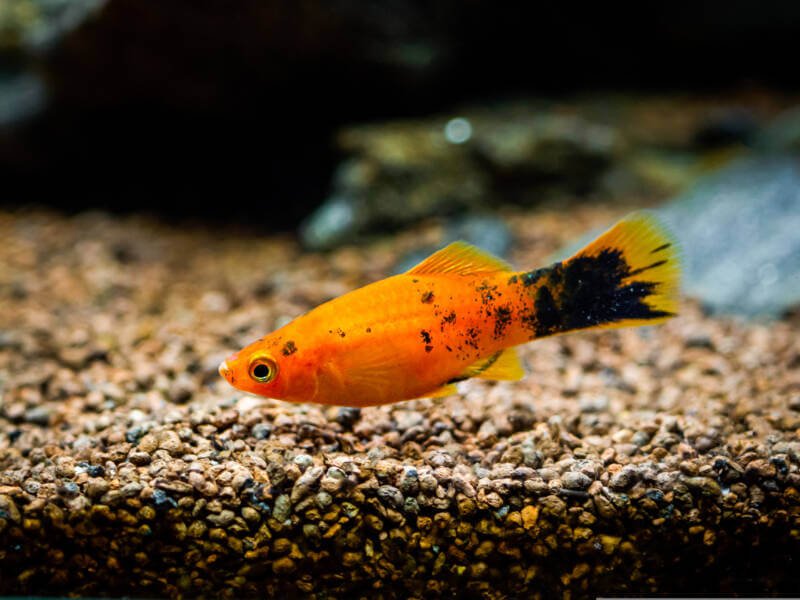
- Variable platy (Xiphophorus variatus), also known as variatus platy or variegated platy;
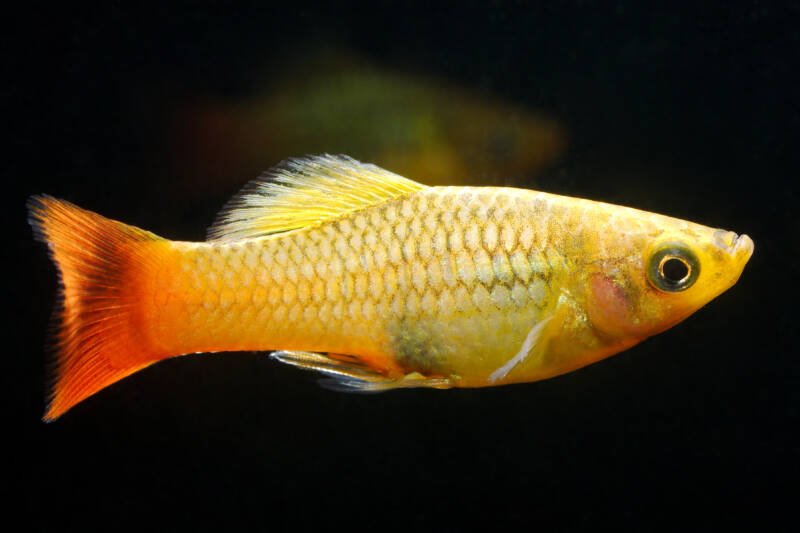
- Swordtail platies (Xiphophorus hellerii) are known as swordtails.
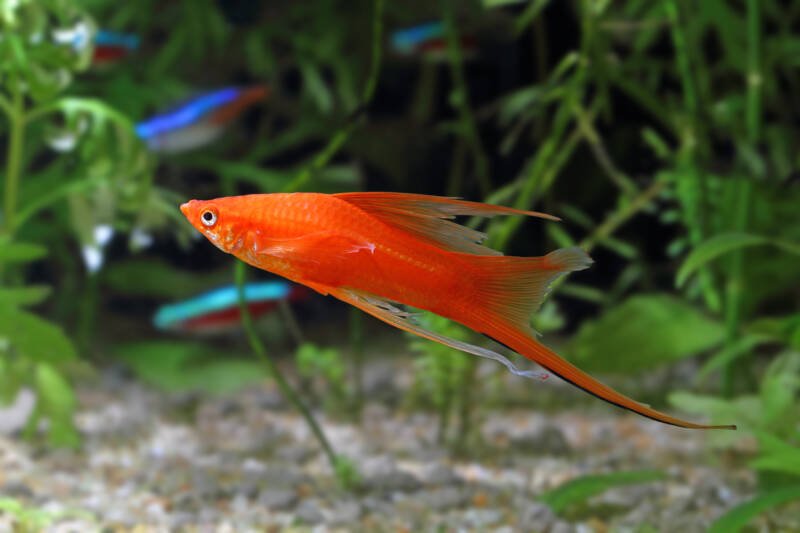
The first two are fairly common and have been interbred so heavily that it is difficult to tell them apart. The swordtail platy is less commonly available in the trade.
Even so, all three vary slightly in shape, color, and fin size, they have the same general characteristics and care requirements.
Size
Platy fish grow to approximately 3 inches or 7,6 cm; males will be slightly smaller than females.
Sexing
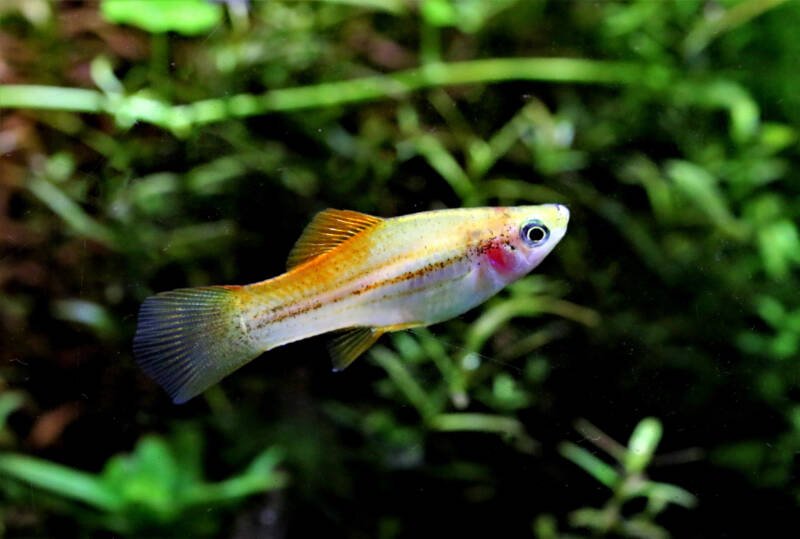
Though platies do exhibit sexual dimorphism (meaning males and females are different in appearance and behavior), it’s hard to sex them until they hit maturity around 4 months. At this point, they become more distinct:
- Male fish are very colorful but develop their coloration more slowly, whereas female platies are plainer but develop more quickly.
- Platy fish fins are fan-shaped and small, especially the dorsal fins, but male platies’ anal fins will grow into a rod shape, called the gonopodium.
Lifespan
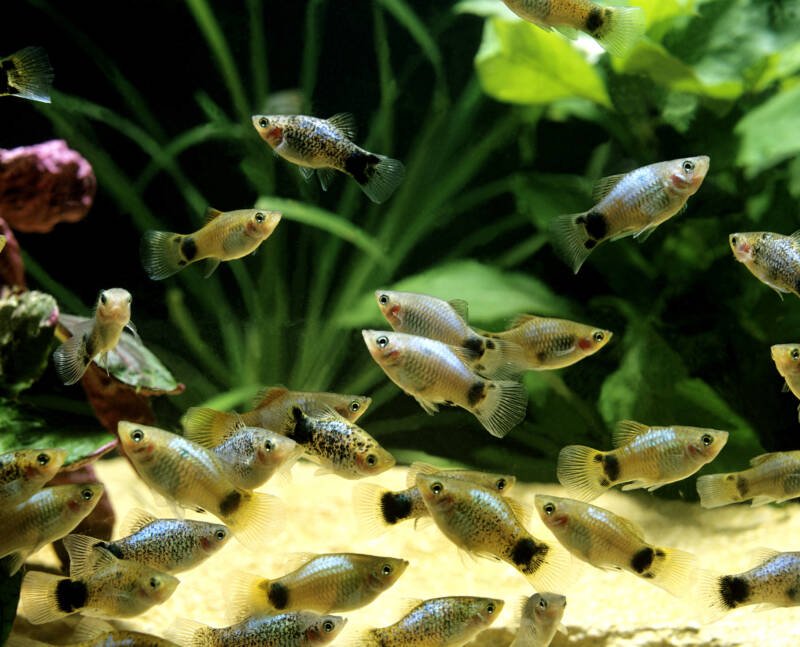
Platy fish are relatively short-lived. They usually live for 3 – 5 years, although some live longer and some die sooner.
Platies are relatively hardy and usually survive the transition from the store setup to the home aquarium. However, they are still susceptible to common illnesses such as ich. Depending on the store you purchased them from, they may be sick when you initially get them.
To ensure they and any other tank inhabitants are healthy and remain that way, it’s best to place your new fish in a quarantine tank for at least one week.
Natural Behavior
Though platy fish are not technically schooling fish, they do better when kept in groups. This makes them more confident and, if the right female-to-male ratio is used, more peaceful.
For reference, there should be three females platies for every male.
Platies are normally very docile and get along with almost all other tank mates. However, if there are not enough females, males can become semi-aggressive and may harass others.
Habitat and Water Preferences

These freshwater fish originally hail from Central America. They can be found in rivers, ditches, canals, springs, marshes, and generally any other small water body.
They inhabit places that meet four main criteria:
- The water is warm;
- There is almost no current;
- There is silt substrate;
- Dense vegetation is present.
They are found in small groups that quickly grow larger as the breeding seasons progress. Platies prefer the middle of the water column, both in their natural habitats and in home aquariums.
Tank Setup

Platy fish need a minimum aquarium size of at least 20 gallons. This is because they are very active fish and prefer to be kept in a group.
Anything smaller won’t allow platies to properly school, although 20 gallons is also a very small tank and limits their natural behaviors.
Increase the tank size for community setups if you want to keep larger schools of platies.
A common rule for measuring how big your tank should be is the “one gallon per inch” rule. However, this doesn’t take into account the specific bioload and needs of each fish. For example, while platies have a relatively moderate bioload, they are very active and need more space.
Equipment
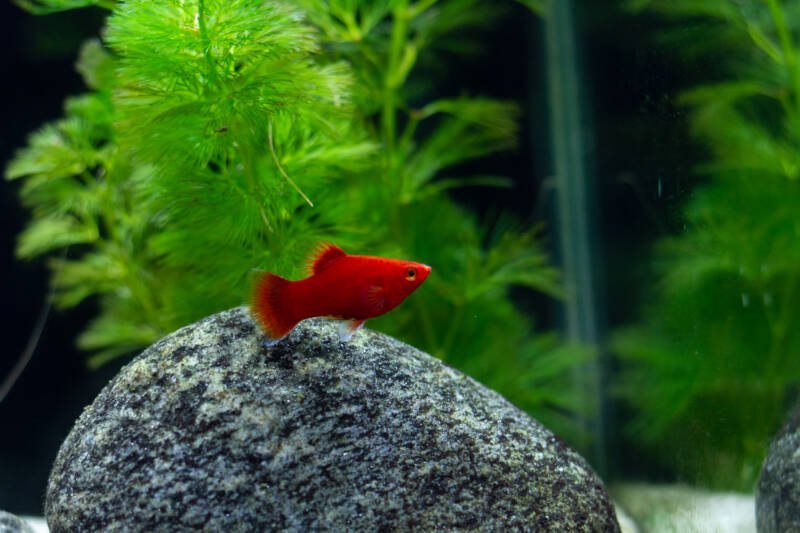
These are hardy fish that are easy to care for. There is very little specialized equipment required.
The necessary specialized equipment relates to the platy’s preference for dense vegetation, but it’s unnecessary if you choose to keep silk fake plants instead of live plants.
- Filtration: Platies prefer almost no current, so HOB or canister filters with strong output flows will need to be modified; hobbyists can also invest in undergravel filters, internal filters, filters with spray nozzles that disperse the output, or filters with weak outputs.
- Heating: These fish don’t need water that is as warm as other tropical species but still prefer it warm enough that a heater will be required. A thermometer is strongly recommended to make sure the tank doesn’t overheat and accidentally kill the inhabitants.
- Lighting: If you use live plants, you should plant them in thick patches that still leave some open swimming spaces. So you’ll need some serious lighting to keep the plants alive. 4500-7000K is a good starting place, depending on whether you choose high or low-light plants.
- CO2 Setup: Low tech planted tanks may be able to get away with using no CO2 or minimal liquid dosing. However, high-tech plants that need more serious lighting will need regular CO2. You can use the pressurized canister setups, DIY setups, or liquid doses.
- Substrate: Silt can be harder to replicate in the aquarium, so a fine-grained substrate is a good substitute. Sand can also be used, although it’s harder to maintain the variety and quantity of plants that platies prefer. It’s best to choose a long-lasting substrate packed with nutrients.
If you choose live plants over silk fake plants, the biggest investment will be for plant-related equipment. This includes the lighting and CO2 setup, although there are options for almost every budget range.
Even so, thoroughly research the current prices on the market to determine what will best suit your setup.
Water Parameters

Necessary water parameters for platy fish are straightforward. They have more strict requirements for pH and temperature ranges but can handle a wide range of dGH:
- pH Range: These swimmers prefer neutral or slightly basic water and have a fairly slim pH range of 7.0-8.0.
- Temperature: Platy fish like water to be kept between 70-75°F (21-24°C), warm compared to other freshwater fish but cooler as compared to other tropical fish.
- Hardness: Platies can handle a water hardness of 10-28 dGH, a large range that underscores their classification as hardy fish.
It’s also important to keep a strict eye on your water quality. Though platies are hardy, they thrive best with weekly water changes and regular tank cleaning.
Regular cleaning will also keep ammonia, nitrite, and nitrate levels as close to 0 ppm as possible. If you have live plants, this will help cut down on the nitrate levels and keep your aquarium water more stable.
However, plants require their own maintenance. Plant debris should be regularly removed, and, if present, algae needs to be removed from plant leaves.
A caveat to this is if you have some snails or other “clean up” crew members. These fish or inhabitants may use plant matter as part of their main diet.
Tank Mates

It’s best to house platies with other peaceful varieties similar in size. This will keep other fish from attacking platies or viewing them as food rather than fellow inhabitants.
Some common tank mates include:
You’ll notice that all of the species listed above are also small and many are prone to schooling. This is because the platy does best with similar fish.
Larger or more aggressive fish such as cichlids or wolffish will likely harass platies, causing undue stress and potentially death.

“Clean up” crew members such as shrimp and snails have also been kept successfully with this species.
Food and Diet
These fish may be small, but they’ll eat as much as you can give them— and more!
They’re omnivores that appreciate a variety of meals, including meaty and plant-based foods.
Interestingly, they often prefer vegetables over meat foods. So while they are omnivores, they do exhibit a distinct herbivorous slant.
Some common foods that aquarists give platies include:
- High-quality flake or pellet food
- Brine shrimp and bloodworms
- Insects and crustaceans
- Plants and plant matter
- Boiled vegetables
- Spirulina and other supplements.
Vegetables, including cucumber, spinach, peas, and squash, are usually accepted.
Platies love eating, but you should only feed them as much as they can feasibly eat in three minutes. You can feed them up to three times per day.
If you notice your fish are eating very quickly or a large amount, watch their stomachs. When it looks like there’s a tiny golf ball stuck in there, it’s time to stop feeding.
You can also use vitamin supplements specifically geared towards enhancing their color. However, a healthy and varied diet should go a long way in keeping their colors clear and bright.
Breeding
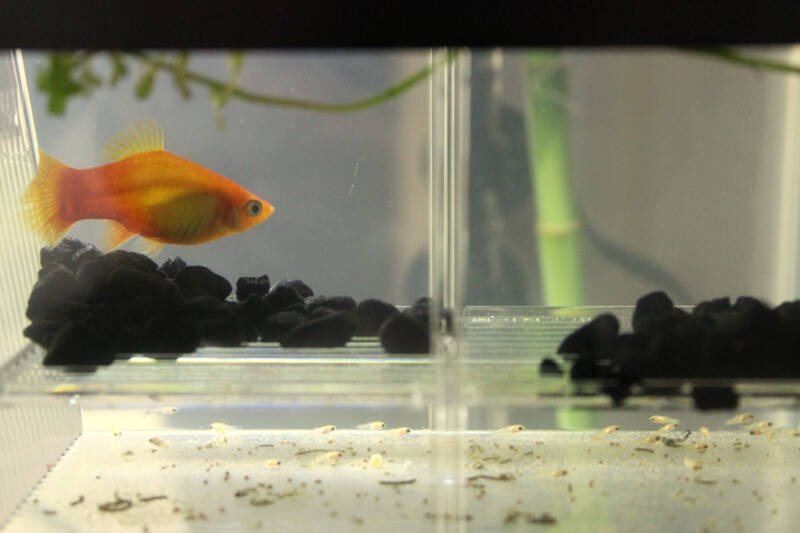
Platies are livebearing species, which means that they give birth to free-swimming fry instead of laying eggs.
It is very easy to breed platies. More often than not, aquarists don’t have to set up a specific breeding tank or take any particular actions to induce breeding.
Instead, you can simply place the fish in your aquarium and let nature run its course. If you have a female and a male, you’ll likely have a successful pair of breeding platies.
But again, it’s important to keep three females to every one male. This prevents males from becoming aggressive, especially when it’s time to mate.
You’ll be able to tell when your platies are pregnant because of their distended bellies. Their abdomens will become very large.
Some aquarists have even reported being able to see the developing eggs and fry if the skin is stretched enough to become transparent. Female platies may also develop a black mark on their abdomen, called a gravid spot.
Pregnant platy will carry for approximately 30 days before giving birth to the fry. They can have up to 80 babies each time they breed and can have several broods throughout the year.
Egg yolk, dry food, infusoria, and other specific newborn food can be fed to the fry until they mature. At this point, they can be moved to the main aquarium (if separated).
Breeding tanks aren’t strictly necessary. However, platy fish have been known to eat their own fry. If you want to avoid this, move the fry to a separate tank as soon as they’re birthed.
Otherwise, parents provide a convenient form of population control. This sounds harsh but is really a benefit since platies often reproduce in great quantity.
If you’re not a professional breeder, this can quickly cause overstocking issues.
Are Platies Right For You?
Platies are great fish to own and are suitable for almost any type of aquarium. They do well in species-only tanks and community tanks, both large and small.
New aquarists can get their hands wet (pun intended!) with this simple fish, while experienced aquarists can continue to enjoy its simple beauty.
They are very hardy and can handle a decent water range, though they naturally have shorter lifespans.
For those looking to breed fish for the first time, platies are a good choice.
They will readily mate and produce fry without much effort. No specific actions have to be taken, such as lowering the water level or changing the temperature.
Breeding can cause its own problems because of how many fry platies produce and how often. But even so, it is still a gratifying experience that instills pride and a sense of accomplishment in hobbyists.
Between the three platy varieties, almost every color and shape of fish is commercially available. Because of this, aquarists can choose the type that suits themselves and their tank best.
You can choose to have red or gold accents among your schools or create a literal rainbow in your aquarium.